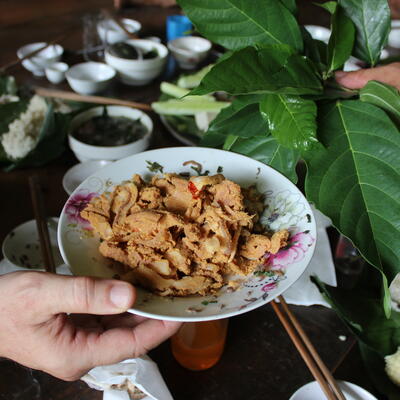
Flies and pork – a love story
Contributed by Martin Heilmann
Flies are attracted to meat – especially pork. And they aren’t the only ones to have this craving: Most people in Uganda really like pork – as is evidenced by Uganda’s having the highest pork consumption per person of all East-African countries (FAO, 2011). This relationship spurred a research project in May 2014 run by the PhD candidate, Martin Heilmann, who is himself attracted to insects in general. Thus, our love story comes full circle. The project, which tries to assess the risk of flies as cross-contaminators, was developed by the Institute of Parasitology and Tropical Veterinary Medicine at Freie Universität Berlin (FUB), funded by the German Academic Exchange Service (DAAD), the CGIAR Research Program on Agriculture for Nutrition and Health and the BMZ funded “Safe Food, Fair Food” project in Uganda which is led by the International Livestock Research Institute (ILRI).
The story:
The first pork joint I saw, a kind of bistro and butchery in one, had its fair share of flies. When I approached a rag was being waved in circles like a propeller to scare away flies. Unfortunately (and scarily from a public health perspective), this resulted in the cloth getting in contact with all but the flies it sought to deter. This vignette marks the beginning of our research focused on cross-contamination – especially by flies as the vector.
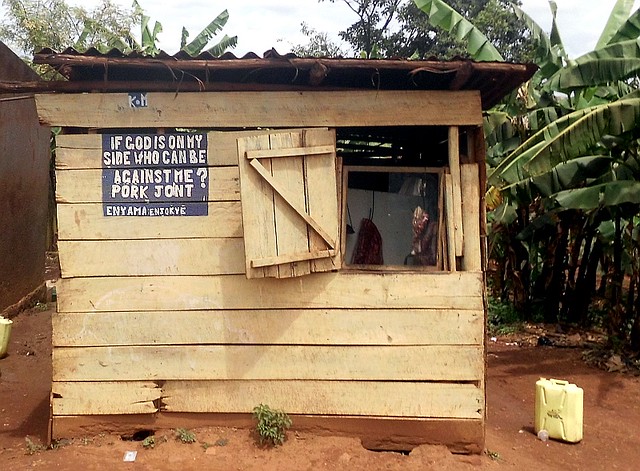
If God is on my side who can be against me? Easy answer–at least for us: Flies! (photo credit: Martin Heilmann, ILRI/Freie Universitaet Berlin).
As a first step in planning, we had to establish a good sample size of pork joints in Kampala. Since we’re talking about a booming and fast-moving business, getting a significant sample of the total population was no simple task. However we could – to some degree – build on a geo-referenced survey made by Joseph Kungu for ILRI in 2013. From the 180 tracked pork joints, we randomly selected 60 for our first interviews. With some significant efforts to locate all these joints, we could finally begin. Thanks to our Boda boda [1] driver Jasper, whose patience, spatial memory and peacefulness were essential for our success and who protected us many times against suspicions that “the mzungu [foreigner] wants to close down our business…”
Thus with the kind assistance of our colleagues, Angella Musewa and Samuel Maling, from Makerere University, we managed to start the baseline by interviewing 60 butchers and 240 customers. From June to July 2014, we asked them about socioeconomics, consumption, buying and selling habits. In parallel, we sampled pork, the surrounding environment, water, relish and flies’ midguts for Salmonella. This sampling work was conducted with help from the Central Diagnostic Laboratory and one of its key team members, Dickson Ndoboli (ILRI intern), who is still courageously helping us.
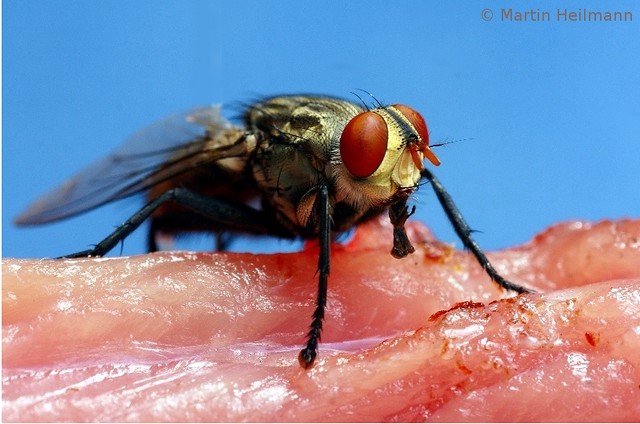
Suspect on pork: Since flies reduced their mouth parts, they liquefy their food by using saliva and suck it up with their proboscis (Sarcophaga sp.) (photo credit: Martin Heilmann, ILRI/Freie Universitaet Berlin).
After an introduction, some free sodas and key phrases in the local language Luganda, we established a good collaboration with most pork joints, their butchers and customers as well. In August, after a three-week, zero value survey as a baseline on the abundance of flies in pork joints, we kicked off an intervention to introduce insecticide-treated nets into eighteen pork joints; on top we kept 5 joints as a control group. The nets were adapted individually to the pork joints’ physical layout. This generally meant constructing custom-sized wooden frames to meet the unique proportions of each pork joint’s windows—where the mesh-covered frames would be installed. To build these frames, the author temporarily adapted his hotel room into a workshop (details available upon request). Since then we have been monitoring the prevalence of flies (calculated by counting the number of these caught in specialized unscented glue traps strategically placed in each pork joint) on a weekly basis and tracking weather conditions and environmental impacts for at least three months.
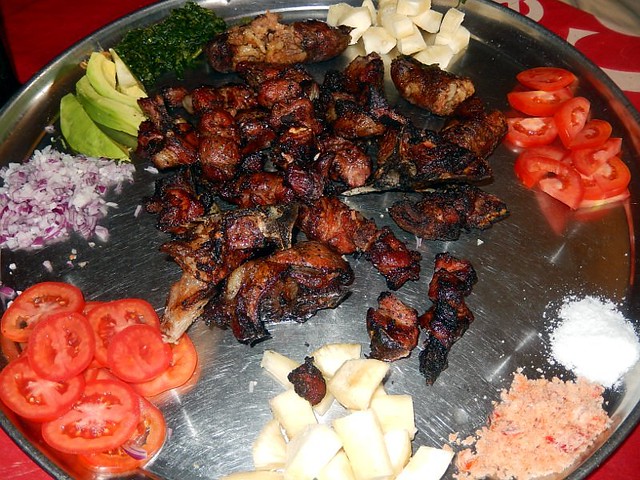
Ready for human sampling. A typical plate served with fried pork and raw relishes (photo credit: Dickson Ndoboli, ILRI/Makerere University).
Meanwhile, we have begun the data analysis of the interviews and, thanks to the help of Dr Nadhem Mtimet, Agricultural Economist at ILRI Nairobi, we already have some interesting results – especially from a choice experiment we conducted within the interviews. More information on this experiment can be found in an upcoming November publication.
Incidentally and over time, the project has been influenced by Ugandan’s coziness. Therefore, it is a bit behind schedule and has been extended by one more month. This extra time could potentially allow us to start another questionnaire that could lead to a willingness-to-invest study and a better feedback as a way to give back and provide the participants in our study with practical information to improve their businesses.
A more detailed presentation is planned for the end of November at ILRI Nairobi during a seminar or the Food Safety and Zoonosis program led by Dr Delia Grace, who has kindly taken on the role of supervisor to this project in conjunction with Professor Peter-Henning Clausen from FUB.
However, the group of involved researchers is not short of results, flies, engagement and support.
On that note: A big thank you to all!
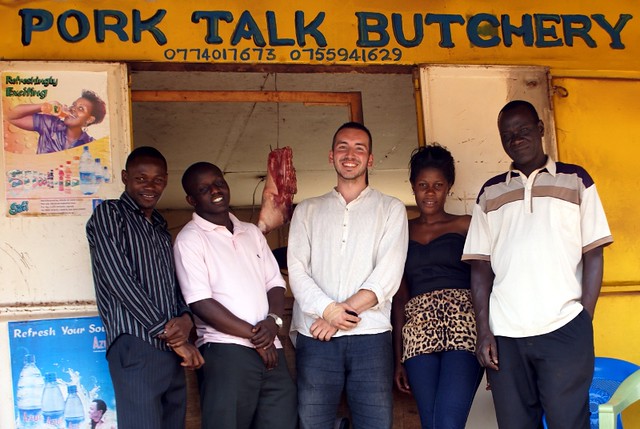
The motivated team from left to right: Samuel, Dickson, Martin, Angella, Jasper. (photo credit: Martin Heilmann, ILRI/Freie Universitaet Berlin).
For additional information, please get in touch with Martin by email: Martin.Heilmann(at)fu-berlin.de
[1] Boda boda = local motorbike taxis: they initially shuttled people between border posts, from ‘border to border’. In East African vernacular this was conveniently shortened to boda boda.











